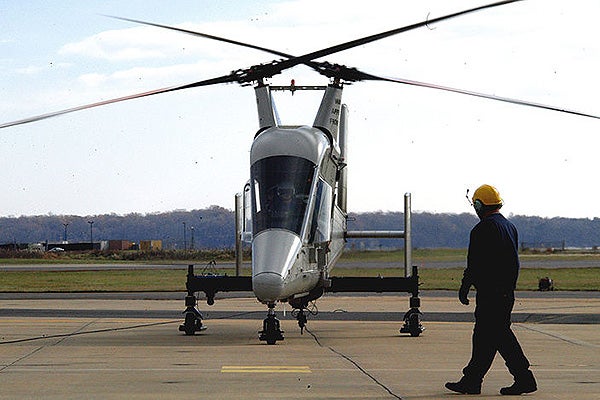
K-MAX is a multi-mission unmanned aircraft system (UAS) jointly developed by Lockheed Martin and Kaman Aerospace. It can be deployed to perform cargo resupply missions in the battlefield.
K-MAX is the US Navy’s first cargo UAS to operate in the combat environment. The UAS features enhanced operational safety and reliability, and has autonomous take-off and landing capability.
The US Army Robotics Technology Consortium awarded a contract to Lockheed Martin, in February 2014, to demonstrate the K-MAX system’s capability to transport the company’s squad mission support system (SMSS) unmanned ground vehicle via sling load to a simulated area of interest.
Design and features of K-MAX
The unmanned helicopter was developed based on the K-MAX heavy-lift aerial truck helicopter. The UAS features low noise signature and requires low maintenance and operating costs. Its platform was designed by Kaman, while mission management and flight control system were developed by Lockheed Martin.
The helicopter is equipped with a four-hook carousel to carry multiple loads in a single flight. It is optionally fitted with a single seat cockpit for maximum flexibility.
MQ-1C Gray Eagle is an extended range / multipurpose (ER/MP) unmanned aircraft system (UAS) developed by General Atomics Aeronautical Systems for the US Army
The UAS has a maximum gross weight of 5,443kg and take-off weight of 3,175kg. It has an empty weight of 2,334kg and can carry a useful load of 3,109kg.
Sensors
The unmanned aerial vehicle is equipped with line-of-sight (LOS) and satellite-based beyond line-of-sight (BLOS) data link systems to provide continuous communication between the aircraft and GCS. It is also fitted with mission management and redundant flight control computers to provide superior flight autonomy in severe environments and over long distances.
Ground control station
The K-MAX drone can be controlled by a ground control station (GCS) consisting of a rugged laptop with command-and-control software. The GCS provides mission flight plan to the mission management computer (MMC) prior to launch.
The MMC transmits the UAS status and flight data to the GCS and new mission plans can be fed to the UAS any time during its flight. The receiving controller at the drop zone guides the aircraft to perform precision load delivery.
K-MAX UAS engine and performance
The K-MAX UAS is powered by Honeywell T53-17 gas turbine engine, which produces a power of 1,800shp. It uses an average of 321.7L (85 gallons) of fuel per hour. The engine directly drives the intermeshing main rotors as the UAS features no tail rotor system. This feature ensures a high lift performance in hot and high conditions.
The drone has a maximum airspeed of 185.2kmph. The airspeed of the UAS with external load is 148.2kmph. The maximum range is 1,852km, while the range with external load is 396.3km, and 494.5km without. The UAV can carry out missions for more than 12 hours. It can lift and deliver 2,722kg of cargo at sea level.
K-MAX UAS demonstrations
Kaman and Lockheed Martin signed a strategic relationship agreement in March 2007 to address the requirements of the US Department of Defence (DoD). The team demonstrated the K-MAX unmanned system to the US Army and the USMC at Quantico in April and November 2008 respectively. The UAS successfully delivered a sling load of 3,000lb during the demonstration. The system also performed a flight test in the Colorado Rockies in July 2009.
The K-MAX UAS carried different loads at 15,000ft in restricted air space at the Army’s Yuma Proving Ground during its demonstration in November and December 2009. The flight tests demonstrated the system’s ability to operate during the nights and to unload multiple cargoes at beyond line of sight (BLOS) ranges.
In August 2009, the team secured a contract from the USMC to demonstrate the system’s capability to deliver cargo to troops at forward operating bases in Afghanistan. The demonstration was completed at the Dugway Proving Ground in Utah in January 2010.
The UAS successfully carried a sling load of 1,500lb at 12,000ft during the demonstration. It delivered 3,000lb of cargo within the specified time of six hours. The flight test also demonstrated remote control operation, precision cargo delivery by the ground control station’s operator during day and night, and uploading a new mission plan to the mission management computer of the UAS during flight.
Kaman and the Army’s Natick Soldier Research, Development and Engineering Center (NSRDEC) conducted 11 cargo airdrop flight tests from 300ft to 400ft altitudes above ground level at Kaman’s Bloomfield facility in Connecticut in April 2010. During one flight, K-MAX performed four airdrops using four-hook carousel in a single mission.
The unmanned cargo helicopter performed a flight test using its heli-basket system to transport an all-terrain vehicle at the Bloomfield facility in November 2010. A multi-hook carousel system was also used for aerial logistics delivery missions.
K-MAX UAS deployments
In December 2010, Lockheed and Kaman secured a $45.8m contract from the US Naval Air Systems Command to deliver two UAVs and three remote control ground stations (GCS) to perform unmanned cargo resupply for the USMC. A five-day Quick Reaction Assessment of the drone was completed in September 2011.
In November 2011, the system was deployed by the USMC to deliver cargo and resupply troops in Afghanistan for six months. The authority extended the aerial vehicle service in Afghanistan through September 2012 and then again for an additional six months. It also has an option to extend K-MAX’s deployment through September 2013.
Kaman and NSRDEC conducted four flight tests of the K-MAX unmanned aerial vehicle at Yuma Proving Ground in January 2011. The UAS completed multiple guided airdrops with sling load at a height of 10,000ft above sea level. It successfully delivered 16 payloads and ten GPS-guided Joint Precision Aerial Delivery Systems.







.gif)
